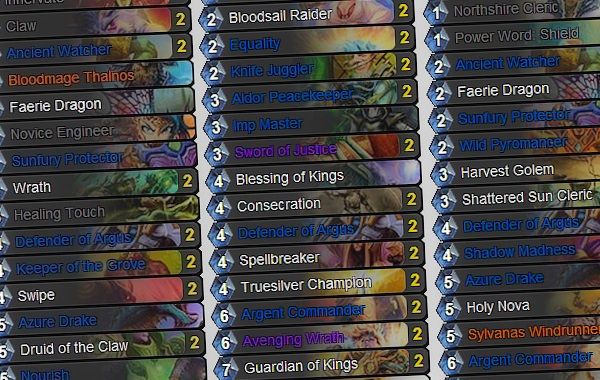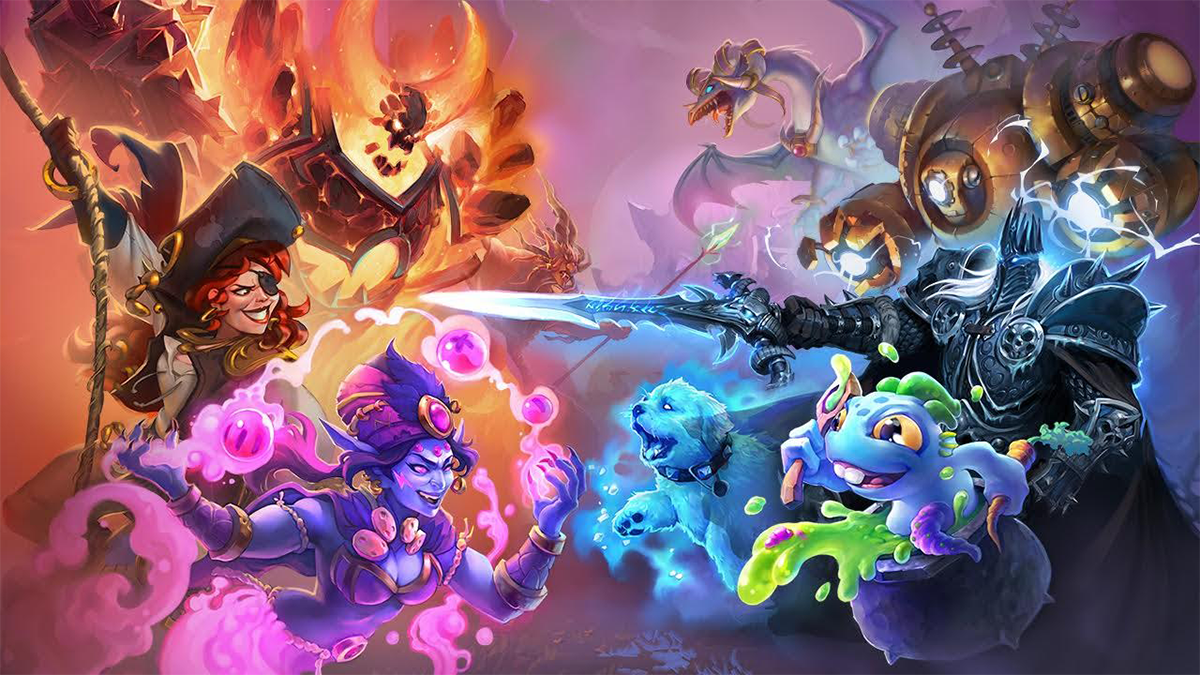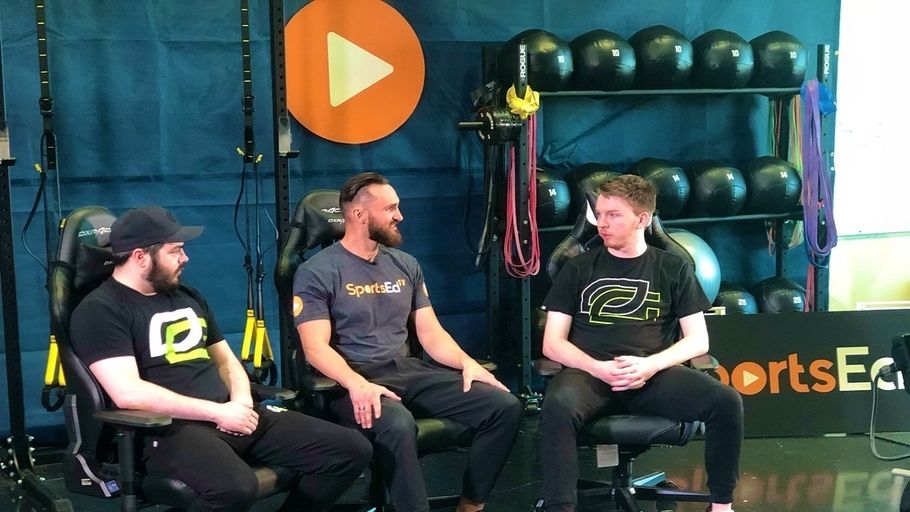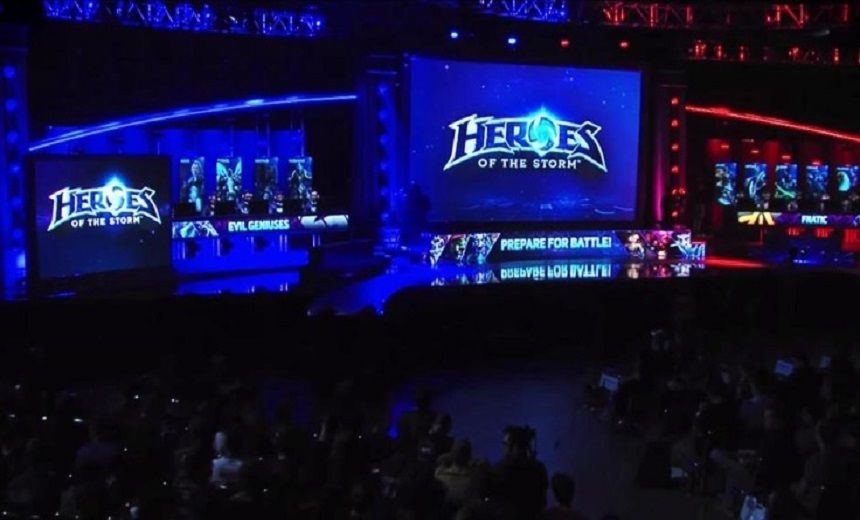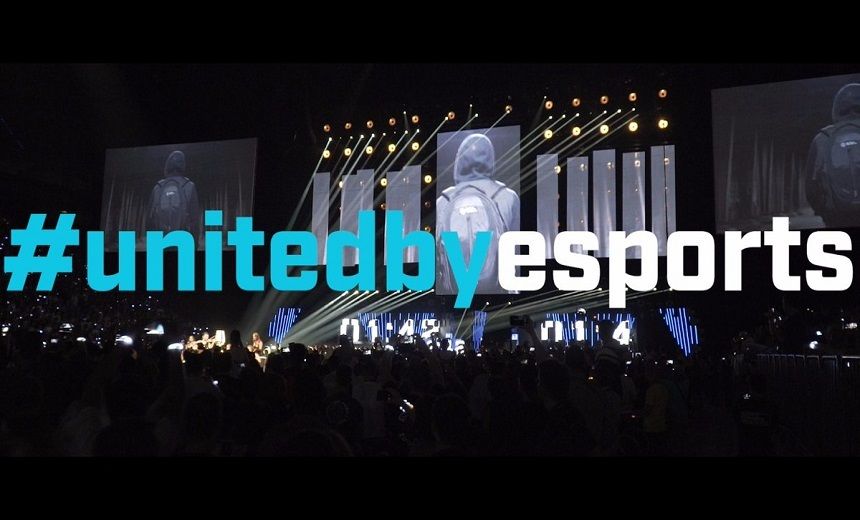It wouldn't be a wild exaggeration to say the NA and Europe constructed meta of Hearthstone is stale. A few weeks ago, Warlock and Rogue aggros dominated the competitive scene, their power only recently countered by the rise of the Mage which in turn became the class that is most often encountered in ranked mode. The cookie cutter decks have long been established and at the moment you have to play quite a few games before encountering a different build of the reigning classes, let alone a different class altogether.
The Asians, however, have always had their own way of playing video games and Hearthstone is no exception. When the NA vs CN 2P championship was announced, followers of the competitive scene were excited to find out what China can bring to the table. Hopefully, it wouldn't be a complete copy of the western meta.
And indeed it wasn't as the Chinese brought classes and specs not exactly popular on NA and EU servers. Below, we take a look at China's decklists that managed to give NA a hard time and bring the grand final series all the way to the seventh Bo3.
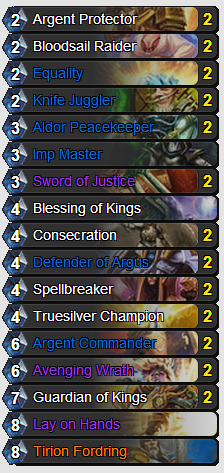 In the rare cases I’ve encountered fellow Paladins in ranked mode (before the complete Mage dominance), the trend has been a transition away from the miniatures spec popularized by Cixah and into a more mid-range control style. It seemed that Paladin players have finally accepted the fact that their T1 and T2 will never be as strong as Warlocks’, Rogues’ or Mages’ and have decided to instead abuse where they shine the most – mid-game board control combined with heavy, end-of-the-curve finishers and healing mechanics.
In the rare cases I’ve encountered fellow Paladins in ranked mode (before the complete Mage dominance), the trend has been a transition away from the miniatures spec popularized by Cixah and into a more mid-range control style. It seemed that Paladin players have finally accepted the fact that their T1 and T2 will never be as strong as Warlocks’, Rogues’ or Mages’ and have decided to instead abuse where they shine the most – mid-game board control combined with heavy, end-of-the-curve finishers and healing mechanics.
Thus it made all sense when the Chinese didn’t bring a single pure Paladin aggro to the grand finals. They knew a miniatures spec could not consistently win against the top tier aggro specs or against the popular frost Mage controls: the deck needed to draw well and either have a perfect low-mana starting hand or draw Truesilver Champions to make it difficult for the Pyrofrost controls to burn it down.
The spec on the right completely forgoes the 1-drops and relies on mid-game combos to win. Bloodsail Raier and Imp Master synergize perfectly with the two Swords of Justice and the pair of Knife Jugglers. The Aldor Peacekeepers come in to negate opponents’ big minions (1/8 Mountain/Molten Giants are much worse than 8/8 after all). Avenging Wraths and Argent Commanders are a must-have as the best 6-drops a Paladin deck can have. The curve ends with Guardian of Kings and Lay on Hands which are almost a hard counter to burn-down Mage decks, and Tirion Fordring, who shines in the current meta where few decks bring hard removal like Assassinate or Siphon Soul.
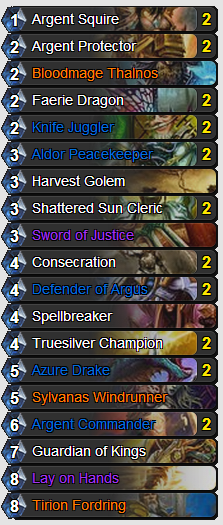 A powerful part of the deck is the Equality/Consecration combo, which is among the best board sweepers in the game. It clears the opponents’ board from everything besides divine shielded minions (they’re cleared with a recruit after the shield pops) and is a great way to get ahead. It reduces all allied minions to 1 toughness, too, but by T6 this rarely matters: they’ll die to any late-game card anyway and because most of them have low toughness to being with, the Equality/Consecration will hurt the opponent way more that the Paladin.
A powerful part of the deck is the Equality/Consecration combo, which is among the best board sweepers in the game. It clears the opponents’ board from everything besides divine shielded minions (they’re cleared with a recruit after the shield pops) and is a great way to get ahead. It reduces all allied minions to 1 toughness, too, but by T6 this rarely matters: they’ll die to any late-game card anyway and because most of them have low toughness to being with, the Equality/Consecration will hurt the opponent way more that the Paladin.
The deck on the left is a slightly different iteration of the same idea. It doesn’t feature the Equality/Consecration combo or Avenging Wraths as finishers and instead relies on Thalnos and Azure Drake to buff the board sweepers and draw cards. A couple of Faerie Dragons are used to screw with Mages. The end-game card pool is the same: Argent Commanders, Guardian of Kings, Lay on Hands and Tirion.
So which deck should an aspiring Paladin player copy? My personal suggestion is to make a blend of the two. The option on the left is a good base since it has great value minions that the other spec doesn’t have (Argent Squire, Faerie Dragon) but it can benefit greatly from Avenging Wrath (a great way to clear the board and/or finish a Mage who’s hiding behind an Ice Barrier). Experiment around with Blessing of Kings or Hammer of Wrath. Replace Tirion with Ragnaros if you don't have him (or like him better). The deckbuilding flexibility that the Paladin offers is among the best features of the class so don't hesitate to try deviate from the decklists and try new stuff.
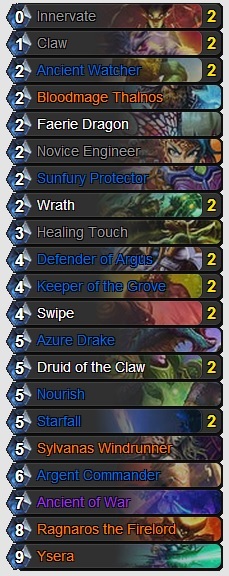 Druids were never that common in Hearthstone because the meta never accommodated their playstyle. In the early control-heavy days, they’d see their largest creatures Mind Controlled away from them, killed by hard removal or copied through Mirror Entity. When the tendency switched to aggro decks, they’d enter the mid-game heavily bruised and their big taunters would be silenced or hard-killed upon arrival.
Druids were never that common in Hearthstone because the meta never accommodated their playstyle. In the early control-heavy days, they’d see their largest creatures Mind Controlled away from them, killed by hard removal or copied through Mirror Entity. When the tendency switched to aggro decks, they’d enter the mid-game heavily bruised and their big taunters would be silenced or hard-killed upon arrival.
Nowadays, however, there seems to be a bigger hope for the druids. The aggro decks have gone even more aggressive and they’ve stopped running Assassinates and have reduced the numbers of Polymorphs and silencers to minimum so it has become harder to deal with 5/10 Ancients of War and 4/6 Druids of the Claw that protect their other legendary finishers. At the same time, cards like Healing Touch helps with the fight against Mage, giving you that one extra turn of life.
The Chinese brought a total of three Druid decks to the grand final and the decklist on the right was used by two of their players. The build is largely different from the standard Druid ramps that can occasionally be seen in play mode. The pair of Innervates and the single Nourish are the only “ramping” cards in the deck and everything else is centered around building a strong wall of taunters that can protect the end-game finishers: Ragnaros and Ysera.
One interesting card in particular that is gaining more and more love with non-Mage controls is Ancient Watcher and we see two copies of it used here. Ancient Watcher synergizes well with Sunfury Protector and Defender of Argus who turn it into a 4/5 or 5/6 taunter, respective, which can trade well against the aggro builds even if it cannot attack. With Innervate, the Sunfury + Watcher combo can be out on T2 and even on T1 if there’s The Coin in hand.
The mana curve of the deck is built in such a way that there is a taunter played on almost every turn. If we don’t account for Innervate, the deck can have a T3 Ancient Watcher + Sunfury, a Defender of Argus on T4, a Druid of the Claw on T5 and Ancient of War on T7. To ensure for the seamless flaw of threats and to most efficiently find its finishers, this deck uses a lot of card draw mechanics, too, in Loot Hoarder, Novice Engineer, Wrath, Azure Drake and Nourish. Claw, Swipe and Starfall keep him alive while Keeper of the Grove silences big threats or clears the board from small creatures. When the board is overgrown with taunters, the Druid casts Ragnaros or Ysera and finishes the opponent from there.
The second version of the deck ran a slightly different build, replacing one Loot Hoarder with a second Nove Engineer and dropping Nourish to run a Faceless Manipulator.
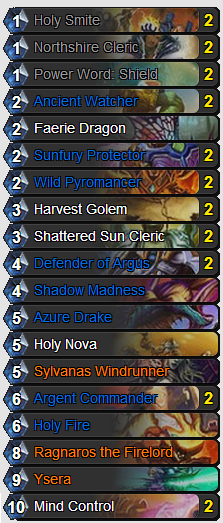 Two months ago, the Priests were the top dog in Hearthstone but not anymore. The rise of the aggro decks abused their slowness and forced them into submission. That’s why it was somewhat surprising to see Priest decks being brought along and even more surprising was the fact that they won games.
Two months ago, the Priests were the top dog in Hearthstone but not anymore. The rise of the aggro decks abused their slowness and forced them into submission. That’s why it was somewhat surprising to see Priest decks being brought along and even more surprising was the fact that they won games.
The Chinese spec was a weird one compared to the bit more standard version that Proteinninja used. Even though it still used many of the cards ubiquitous to Priest decks, MVP cards like Holy Nova, Shadow Madness and Holy Fire were ran 1x (Shadow Word: Pain wasn’t even used). In their place, it runs a couple of Wild Pyromancers which is an odd choice by itself considering there are just nine spells in the entire deck that can trigger its effect (three of those are strictly mid/late game).
The worst thing about talking about this deck is that it won’t work after the patch (so there go a few hundred words wasted). Its build around delaying the game through taunters and Mind Controlling the late-game finishers but with the spell now at 10 mana this strategy becomes incredibly risky. Two turns later means two more turns of life for Ragnaros or Tirion which will be game breaking.
Thus, out of all the decks discussed here, this one will need the most revising for certain, and the Mind Controls should ideally be replaced with additional copies of Holy Fire, Holy Nova or Shadow Madness. Ysera might also be too much of a late game minion and if Druids can ramp for her, Priest cannot and neither can they protect her through Mind Control on T8.
There wouldn’t be a proper Hearthstone tournament without a handful of Mage decks and so here they are.
All three different Mage players of the Chinese team ran a different Mage deck. The farthest on the right is the Mage Giants set-up popularized by the DogeHouse team. It's a form of Ice Block control that features lots of draw mechanics and plays "dangerously" so it can cast cheap Mountain Giants and Molten Giants. The deck delays the game through freeze spells until he can get a few finishers out and finish the opponent. Common final turns for this deck are 2 giants at T8, followed by Alexstrasza on T9 and a swing for lethal.
The middle deck is an aggro Mage but in a slightly different set-up that's seen in the western meta. There's one Mana Wyrm as the single 1-drop (traditional aggro mages run Argent Squires, Leper Gnomes or Arcane Missiles for bigger sinergy with the Wyrm). It has replaced the Dark Iron Dwarfs with Chillwind Yetis and runs a pair of Loot Hoarders for extra draw. There's no Cone of Colds as they're replaced with a Ragnaros and one extra polymorph. It looks to be a slightly less aggressive deck and oriented towards more expensive cards.
The third deck is the original form of Ice Block control that appeared before the Giants control was invented. It has some form of early-game pressure through double Mana Wyrm, double Faerie Dragon and a Sorcerer's Apprentice and also uses Coldlight Oracle for additional draw.
One curious thing to notice in this build is the Mad Bomber (the minion will also appear in the Warlock set-up shown below). The Bomber was played exclusively in the Chinese decks and is their way of dealing with pesky minions like Blood Imp, Argent Squire and Faerie Dragon. While there's always the risk of his ability to horribly backfire, when played at the right them Mad Bomber will more often than not give value for money.
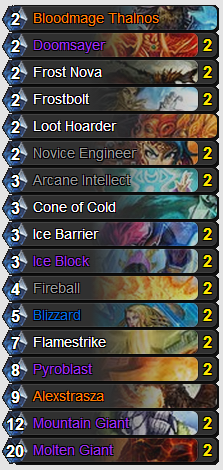
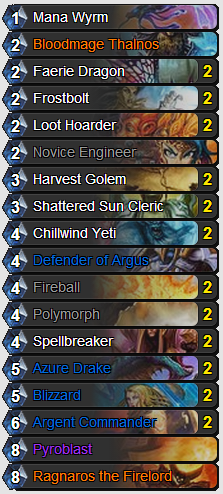
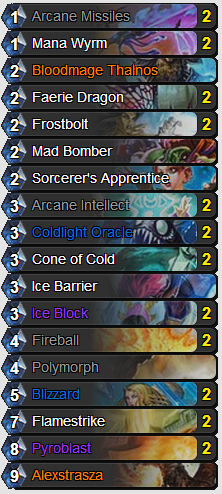
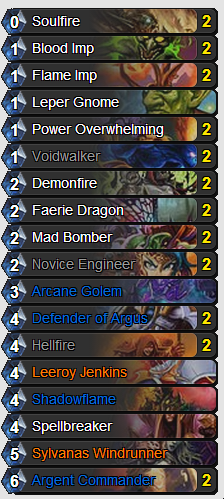 Right now, the Warlock aggro build in the Western meta is pretty much set. There are but a few minor deviations in whether or not some form of board control is present (Shadowflame) and whether or not the curve ends with Jaraxxus. You start the game with 1-drops and constantly buff them with Shattered Sun Clerics, Defenders of Argus and Blood Imps to establish a menacing board of minions. It’s a powerful and well-rounded playstyle and one that also feels very “safe” to play in the sense that you barely take any risks.
Right now, the Warlock aggro build in the Western meta is pretty much set. There are but a few minor deviations in whether or not some form of board control is present (Shadowflame) and whether or not the curve ends with Jaraxxus. You start the game with 1-drops and constantly buff them with Shattered Sun Clerics, Defenders of Argus and Blood Imps to establish a menacing board of minions. It’s a powerful and well-rounded playstyle and one that also feels very “safe” to play in the sense that you barely take any risks.
The Chinese being Chinese run the Warlock differently. The build shown on the right is certainly more manic and feels much more Warlock-esque than the standard western set-up. The madness starts right from the low mana, featuring a pair of Mad Bombers (as we mentioned, those are for dealing with otherwise untargettable or hard to kill minions like Argent Squire and Blood Imp) and two copies of Power Overwhelming (most of the traditional Warlocks use just one as a finisher).
The latter greatly help the deck’s idea of going straight for the face and hitting big while disregarding any possible drawbacks. When most of the builds will run either Leeroy or Arcane Golem as finishers, this build runs both and they greatly synergize with Power Overwhelming. There’s a single copy of Leper Gnome which, if PO’d, can hit for 8 on T2 and also works great with Shadowflame.
What’s more, where in traditional Lock builds you’ll see double SSC, here they are replaced with a pair of Hellfires, a spell that is often avoided in aggro Warlock builds due its drawback (it’ll clear caster’s board as well). So why is it used here? As pointed out, this build is a bit more “suicidal” than the ordinary, safer set-up and that in turn means it can more easily lose the board race, especially if the opponent runs 2-for-1 minions like Argent Squire or Harvest Golem. Hellfire is there to reset the boards (3 damage will usually kill all but the divine shielded minions) and deal additional 3 damage to the opponent.
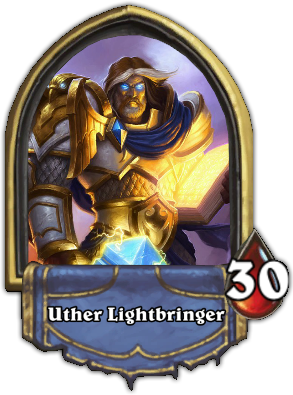 The mid-range heal-heavy Paladin is extremely strong right now especially with Mages being on the rise. A pair of Guardian of Kings, one Lay on Hands and two True Silver Champions equals a total of 28 health back. Even if you don't draw them all, more often than not you'll be able to heal back one Pyroblast worth of damage while drawing cards/dealing damage/setting up heavy threats. The Spellbreakers are also key because they defrost your minions and free them to deal extra points of damage. Equality/Consecration, on the other hand, is just perfect against the Giants!
The mid-range heal-heavy Paladin is extremely strong right now especially with Mages being on the rise. A pair of Guardian of Kings, one Lay on Hands and two True Silver Champions equals a total of 28 health back. Even if you don't draw them all, more often than not you'll be able to heal back one Pyroblast worth of damage while drawing cards/dealing damage/setting up heavy threats. The Spellbreakers are also key because they defrost your minions and free them to deal extra points of damage. Equality/Consecration, on the other hand, is just perfect against the Giants!
Overall, I do believe playing a Paladin this way makes more sense. While I personally maintain a positive ration with the miniatures set-up, the mid-range build seems more stable. It makes for its weaker early turns with very powerful T4 to T6. Tirion is amazing against aggro decks and it can be subbed out for Ragnaros if you expect to face more control oriented opponents.
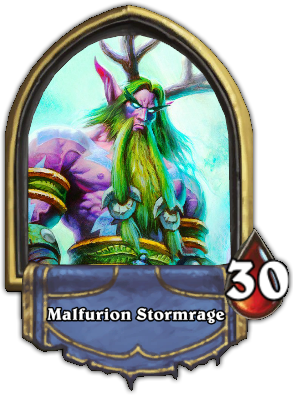 The Druid players should really consider investing resources into building a strong deck as it has a lot of potential right now. The Chinese set-up might need adjusting a little to feature Ancient of Lore (cards or heal are both amazing alternatives right now) and a second Argent Commander but other than that it looks very solid. Control Mages should have a lot of trouble against it since they can't clear the board with Cone of Cold or Blizzard and will have to use Fireball to clear threats which in turn means no Fireballs to Druid's face. Aggro decks, on the other hand, will have troubles going through the high-toughness minions since most of them don't run silence and hard removals in big numbers. The deck has a lot of legendaries and It's an expensive investment but if you have the cards I'd suggest giving it a try.
The Druid players should really consider investing resources into building a strong deck as it has a lot of potential right now. The Chinese set-up might need adjusting a little to feature Ancient of Lore (cards or heal are both amazing alternatives right now) and a second Argent Commander but other than that it looks very solid. Control Mages should have a lot of trouble against it since they can't clear the board with Cone of Cold or Blizzard and will have to use Fireball to clear threats which in turn means no Fireballs to Druid's face. Aggro decks, on the other hand, will have troubles going through the high-toughness minions since most of them don't run silence and hard removals in big numbers. The deck has a lot of legendaries and It's an expensive investment but if you have the cards I'd suggest giving it a try.
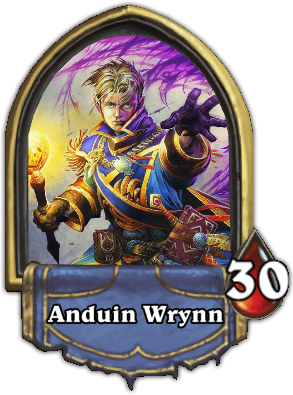 As mentioned, the Priest set-up will likely not work. Some core concepts of it can still be used (Ancient Watchers combined with Silence/Sunfury/Defender of Argus are just amazing) but it needs to find better ways of protecting its late-game threats. Another copy of Holy Fire is a must, as is a second Holy Nova. Shadow Word: Death needs to be in it even if it's just one copy to more easily deal with Mage's giants. It will further need another Shadow Madness to more effectively battle aggro decks or at least run an Auchenai Soulpriest/Circle of Healing/Earthen Ring Farseer combos.
As mentioned, the Priest set-up will likely not work. Some core concepts of it can still be used (Ancient Watchers combined with Silence/Sunfury/Defender of Argus are just amazing) but it needs to find better ways of protecting its late-game threats. Another copy of Holy Fire is a must, as is a second Holy Nova. Shadow Word: Death needs to be in it even if it's just one copy to more easily deal with Mage's giants. It will further need another Shadow Madness to more effectively battle aggro decks or at least run an Auchenai Soulpriest/Circle of Healing/Earthen Ring Farseer combos.
Overall, the Priests will need to come to terms that Mind Control is a dead card in constructed and that the old playstyle of "stay alive and steal stuff in late-game" is no more.
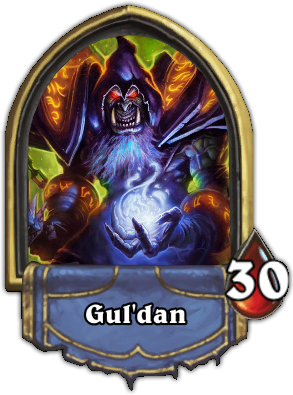 There's nothing I can comment on the Mages that you already don't know so let's move on to the Warlock. After testing both builds, I can't really say which one has a significant advantage: The results I've been getting on the ladder indicate that the Western build might be just a tad bit more consistent but not nearly to the extent that it makes other builds not viable.
There's nothing I can comment on the Mages that you already don't know so let's move on to the Warlock. After testing both builds, I can't really say which one has a significant advantage: The results I've been getting on the ladder indicate that the Western build might be just a tad bit more consistent but not nearly to the extent that it makes other builds not viable.
That said, the Chinese build does feel more fun to play. It's way more flavorful and fits the idea of the Warlock about winning without thinking of the consequences perfectly. It hits really hard and makes for some explosive finishes. Try it out, you won't regret it (plus you must be tired of the traditional set-up already.
I'm glad you asked. Check the table below. Hop on here to see every single decklist from the event.
|
#1: Mage vs Mage |
#1: Mage vs Druid |
#1: Paladin vs Druid |
#1: Rogue vs Priest |
|
#1: Priest vs Paladin |
#1: Priest vs Warlock |
#1: Mage vs Mage |

